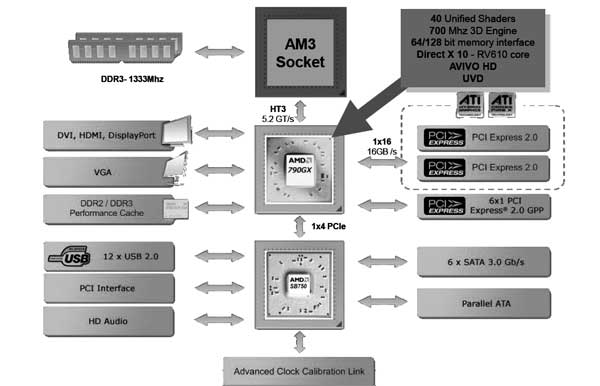Meet the Phenom II processor platform
Meet the Phenom II processor platform
With the successful launch of Phenom II processors, AMD started to further improve their chip design and overall performance. Squeeze more performance out of them, reach higher clock-frequencies, yeah the truth is, it isn't looking so bad anymore, no sir. I think roughly half of the PCs in my office alone are Phenom II based computers. I like the price, and I certainly like the performance very much, plus they are very energy efficient with the AMD 790 chipset.
So, while in early January AMD released Phenom II processors, in early February the first Phenom II update was already released. AMD Phenom II processors with a new socket design, Socket AM3, which opens up DDR3 memory support. The good thing, Socket AM2+ (DDR2) motherboards can run these AM3 processors fine (mandatory BIOS update required though). But fact is... that is a stackload of compatibility for sure as you can use a DDR2 memory platform with AM3 processors.
When we reviewed the 1st batch of AM3 processors, we did so on Socket AM2+ to prove how sound that chipset really is. We also promised to review a Phenom II AM3 processor on the new DDR3 (AM3) platform. And that's what we'll be doing today. We will review the Hummer motherboard from the folks at Jetway, armed with DDR3 memory.
The Chipset
So then, the motherboard we are reviewing today is the Jetway Hummer HA08-LF. We will be testing the Socket AM3 version. With this socket change the biggest change of course is support for DDR3 memory and thus Phenom II Socket AM3 processors. Next to that we have the Hummer edition in house, that means pimping the product Jetway style - with a bucketload of features like integrated graphics, dual PCIe graphics ports for Crossfire, HDMI connector, passive cooling, micro-switches, 8-channel sound, GigE ethernet, Crossfire ready... and fairly decent tweakability.
Obviously I am talking about a mainboard based on AMD's latest 790GX chipset. A mainboard chipset that proves its strength and by all means is really fun to work and play around with, a motherboard in the 125-150 USD segment offering a stackload of features alright.
But surely, the chipset is a bit difficult to position. It's feature rich, but what is it? A high-end board or a gamers mainstream chipset? We think it's both as it is extremely flexible and can be used in many segments.

When we break down the chipset we see that the AMD 790GX Northbridge is coupled to the AM3 socket through a HyperTransport 3.0 link. The AMD 790GX core logic is built upon a 55nm fabrication process, which seems to be the key to AMD's motherboard chipset success lately. It actually has a GPU embedded (Radeon HD 3300 Graphics Processor (IGP)) and includes support for DirectX 10, ATI Avivo HD, Unified Video Decoder (UVD).
It supports MPEG-2, VC-1, and H.264 playback, and the HDCP compliant output ensures Blu-ray/HD-DVD output for your PC or big screen. Introduced with the 780G, the 790GX also supports Surround View, for dual monitors in standard mode, or up to four displays using a dedicated graphics card. Therefore often these motherboards will have support for DisplayPort, DVI and HDMI.
The graphics core is virtually identical to the one found in the 780G chipset based products, but in the 790GX, it is clocked higher (700MHz) for up to 33% better performance. New is the presence of 128MB of onboard display 'cache' memory, which AMD has labeled as sideport memory. This actually is an option on the 780G, but you'll find it much more widespread on the 790GX motherboards. It features 128MB of DDR3-1333 memory - on a 128-bit memory bus.
The 790GX supports ATI Hybrid CrossFireX that makes it possible to combine the integrated graphics with discrete ATI Radeon HD 3400 or ATI Radeon HD 2400 cards, which obviously is extremely low end. In its favor, the supported CrossFireX technology supports multi-GPU configurations based on ATI Radeon HD 4800 series just as well. We spot PATA, 6 SATA ports, HD audio, and 12 USB ports supported by the SB750 Southbridge. When you look a bit closer you'll see a new feature called ACC, or Advanced Clock Calibration. More on ACC later though.
When we focus on the new SB750 Southbridge chip then we see a new A-Link Express II interface that the SB750 Southbridge uses to communicate with the Northbridge.
Traditionally a Southbridge chip always offers support for both SATA RAID and IDE drives. The SB750 supports 6x SATA 3.0 Gb/s ports that can be setup in IDE, AHCI, JBOD, RAID 0, RAID 1, RAID 5 or RAID 10 modes, 12x USB 2.0 and 2x USB 1.1 ports, 6x PCI slots, HD Audio, IDE, and Serial and Parallel ports.
A nice improvement in the SB750 (Southbridge chip) over the SB600 is the increase in USB 2.0 performance and the number of ports available. You now have a dual-channel controller sporting 12 USB 2.0 capable ports.
